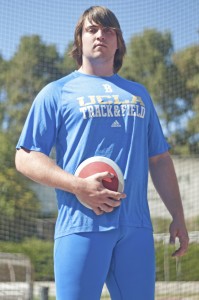There’s big, there’s huge and then there’s Wruck. Measuring 6 feet 6 inches and just a shade under 310 pounds, Julian Wruck is so much bigger than the rest of his competitors, standing out like a tank in a parking lot.
Then he starts his throw, and he begins to spin with such grace and speed that all thoughts about his size disappear. Instead, images of a spinning figure skater start replacing the once immovable tank.
And that is why the redshirt junior discus thrower currently has the world-leading mark in his event.
This track and field season has made Wruck a star. In March, he broke a longtime UCLA school record, set in 1995, while throwing a 2013 collegiate and world-leading mark. The next meet, he broke all three records he had just set. And then for the next two straight weekends, Wruck once again proved records are meant to be broken, by inching out his week-old record two more times.
UCLA track and field coach Mike Maynard has worked with a large number of world-class discus throwers over the years, but even he sometimes finds himself in awe of Wruck’s ability.
“This has been a spectacular year so far and he kind of just keeps getting better and better,” Maynard said. “I would arguably say that he may have already constructed to this point the best season for a collegiate discus thrower ever.”
But to reach this point in his throwing career, Wruck went through a remarkable transformation. Despite always being tall, Wruck never was able to quite fill into his frame despite playing multiple sports growing up, including basketball and rowing.
“I started lifting weights with some of my rowing teammates, and I was the biggest but weakest on the team,” Wruck said. “If you saw me when I first started throwing discus or lifting weights, you would have laughed.”

Now, no one would dare laugh.
Wruck made it clear that although not blessed with natural talent or genetics, aside from his height, he has gotten to his high level of competition by training as hard as he could.
All the hard work paid off in a big way with a trip to the 2012 Olympics. But shortly before what should have been a glorious moment, Wruck developed mononucleosis and lost nearly 50 pounds; and with that, all expectations flew out the window. Wruck ended up finishing just a little below middle of the pack.
While a bit disappointed by his performance, Wruck made the most of his first major competition experience. Finding himself surrounded by discus throwers he looked up to and emulated growing up, he took full advantage.
“To be able to ask them questions in person and talk to them, I really learned a lot,” Wruck said. “It was one of the most helpful experiences of my discus career.”
After stealing some tips and tricks of the trade, Wruck has incorporated some into his own technique. One takeaway from the Olympics, though, is quite apparent.
After seeing all of the best throwers in the world were bigger and stronger, Wruck began to dedicate himself to putting on weight to improve distance. And so after dropping 50 pounds because of mononucleosis, he has been building the tank of a body he has now, gaining about 80 pounds in the last six months.
But to many of his teammates, Wruck’s size isn’t what makes him great. Instead, it is a dedication to discus and a deep understanding of the technique that goes into it. Redshirt junior discus thrower Matthew Kosecki has been able to tap into Wruck’s seemingly endless pool of knowledge.
“He’s really cerebral when it comes to discus,” Kosecki said. “When you have some questions or when you want to have a discussion about the throw, it’s nice to be able to talk to him about it.”
Kosecki isn’t the only one Wruck turns to for technique and training ideas. He makes an effort to talk to and be friendly with other throwers and throws coaches in order to gain that extra bit of advantage via an extra nugget of information to tweak his technique.
“Oftentimes people think you just got to do what everyone else does and follow it,” Wruck said. “If I’m able to understand discus better than other people, then I think I can throw further than them even if my body is not as good as theirs.”
The more Wruck talks about discus, the more it becomes clear that it is not his size that sets him apart from the rest. Despite such massive results from pushing hard in the weight room, Wruck obsesses even more over the details of his technique.
Maynard doesn’t even view himself as a coach for Wruck, but more as a technical consultant and peer, giving Wruck the freedom and independence to make his own decisions.
Wruck can break down each component of the throw, right down to the physics associated with angular momentum and stretch reflex. He claims to not have studied too much physics and that most of it comes from annoying and pestering different throws coaches with questions.
“If you’re willing to take a smart approach to a sport and train hard not in the conventional sense of lifting harder or heavier, but of striving to understand things, then I think that’s what is going to lead to success,” Wruck said.
With the build of a tank, Wruck is able to utilize every inch and pound by meticulously developing his technique through trial and error to form a throw that enchants with an elegance of a figure skater.
What’s especially scary is that Wruck is only just 21 years old.
“This is a sport where people are usually men, not boys or young men,” Maynard said. “This is something that typically takes a long time to develop and here’s a young man who’s on top of the world and maybe the best of his generation, and he’s got a lot ahead.”
